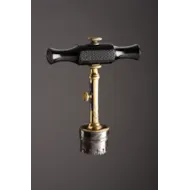Steel and Gilt Brass Surgical Trepan with its Steel Crown Bit and Centre Pin with an adjustable Screw
An English Steel and Gilt Brass Surgical Trepan with its Steel Crown Bit and Centre Pin with an adjustable Screw
The Handle of Turned Ebony
Circa 1820-30
Size: 11cm high, 9cm wide – 4¼ ins high, 3½ ins wide
The Handle of Turned Ebony
Circa 1820-30
Size: 11cm high, 9cm wide – 4¼ ins high, 3½ ins wide
The perforation of the skull or trephining was practiced in prehistoric and primitive societies often to relieve specific complaints such as epilepsy or severe headaches. That the patients survived these operations is known because skulls have been found in many parts of the world with the rims of the skull perforations blunted indicating that healing processes later took place in the bone tissues. The operation was probably both a shamanic ritual and therapeutic for the patient and it is undoubted that these early surgeons using only the sharpened edge of a flint had great technical ability.
Trephines were first mentioned in England around 1600AD as circular saws for removing a disc of bone from the cranium. The saw having a slightly wider shoulder to prevent it sinking into the brain. In the middle of the central shaft is a metal pin for engaging the instrument in the skull. It then rotates either by a brace or drillstock type of handle or later as in this example by a handle set at right angles to the shaft. John Sculters of Ulm (1595-1645) describes trephines both with and without a central pin as being called ‘male and female’. The adjustable screw to raise or lower the pin was introduced from Europe in 1817.
Trephines were first mentioned in England around 1600AD as circular saws for removing a disc of bone from the cranium. The saw having a slightly wider shoulder to prevent it sinking into the brain. In the middle of the central shaft is a metal pin for engaging the instrument in the skull. It then rotates either by a brace or drillstock type of handle or later as in this example by a handle set at right angles to the shaft. John Sculters of Ulm (1595-1645) describes trephines both with and without a central pin as being called ‘male and female’. The adjustable screw to raise or lower the pin was introduced from Europe in 1817.
Steel and Gilt Brass Surgical Trepan with its Steel Crown Bit and Centre Pin with an adjustable Screw

SOLD
YOU MAY ALSO LIKE

